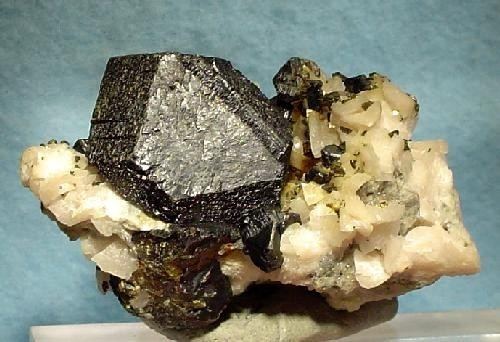Category Sulfide mineral Strunz classification 2.CB.05a Crystal system Cubic | Formula
(repeating unit) (Zn,Fe)S Dana classification 02.08.02.01 | |
 | ||
Crystal class Hextetrahedral (43m)
H-M symbol: (4 3m) | ||
Sphalerite ((Zn,Fe)S) is a mineral that is the chief ore of zinc. It consists largely of zinc sulfide in crystalline form but almost always contains variable iron. When iron content is high it is an opaque black variety, marmatite. It is usually found in association with galena, pyrite, and other sulfides along with calcite, dolomite, and fluorite. Miners have also been known to refer to sphalerite as zinc blende, black-jack, and ruby jack.
Contents
Chemistry
The mineral crystallizes in the cubic crystal system. In the crystal structure, zinc and sulfur atoms are tetrahedrally coordinated. The structure is closely related to the structure of diamond. The hexagonal analog is known as the wurtzite structure. The lattice constant for zinc sulfide in the zinc blende crystal structure is 0.541 nm, calculated from geometry and ionic radii of 0.074 nm (zinc) and 0.184 nm (sulfide). It forms ABCABC layers.
Varieties
Its color is usually yellow, brown, or gray to gray-black, and it may be shiny or dull. Its luster is adamantine, resinous to submetallic for high iron varieties. It has a yellow or light brown streak, a Mohs hardness of 3.5–4, and a specific gravity of 3.9–4.1. Some specimens have a red iridescence within the gray-black crystals; these are called "ruby sphalerite." The pale yellow and red varieties have very little iron and are translucent. The darker, more opaque varieties contain more iron. Some specimens are also fluorescent in ultraviolet light. The refractive index of sphalerite (as measured via sodium light, 589.3 nm) is 2.37. Sphalerite crystallizes in the isometric crystal system and possesses perfect dodecahedral cleavage. Gemmy, pale specimens from Franklin, New Jersey (see Franklin Furnace), are highly fluorescent orange and/or blue under longwave ultraviolet light and are known as cleiophane, an almost pure ZnS variety.
Occurrence
Sphalerite is the major ore of zinc and is found in thousands of locations worldwide.
Sources of high quality crystals include:
Gemstone use
Crystals of suitable size and transparency have been fashioned into gemstones, usually featuring the brilliant cut to best display sphalerite's high dispersion of 0.156 (B-G interval)—over three times that of diamond. Freshly cut gems have an adamantine luster. Owing to their softness and fragility the gems are often left unset as collector's or museum pieces (although some have been set into pendants). Gem-quality material is usually a yellowish to honey brown, red to orange, or green.
